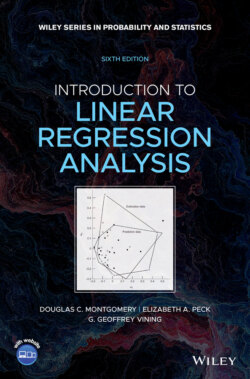Читать книгу Introduction to Linear Regression Analysis - Douglas C. Montgomery - Страница 24
Example 2.1 The Rocket Propellant Data
ОглавлениеA rocket motor is manufactured by bonding an igniter propellant and a sustainer propellant together inside a metal housing. The shear strength of the bond between the two types of propellant is an important quality characteristic. It is suspected that shear strength is related to the age in weeks of the batch of sustainer propellant. Twenty observations on shear strength and the age of the corresponding batch of propellant have been collected and are shown in Table 2.1. The scatter diagram, shown in Figure 2.1, suggests that there is a strong statistical relationship between shear strength and propellant age, and the tentative assumption of the straight-line model y = β0 + β1x + ε appears to be reasonable.
TABLE 2.1 Data for Example 2.1
| Observation, i | Shear Strength, yi (psi) | Age of Propellant, xi (weeks) |
| 1 | 2158.70 | 15.50 |
| 2 | 1678.15 | 23.75 |
| 3 | 2316.00 | 8.00 |
| 4 | 2061.30 | 17.00 |
| 5 | 2207.50 | 5.50 |
| 6 | 1708.30 | 19.00 |
| 7 | 1784.70 | 24.00 |
| 8 | 2575.00 | 2.50 |
| 9 | 2357.90 | 7.50 |
| 10 | 2256.70 | 11.00 |
| 11 | 2165.20 | 13.00 |
| 12 | 2399.55 | 3.75 |
| 13 | 1779.80 | 25.00 |
| 14 | 2336.75 | 9.75 |
| 15 | 1765.30 | 22.00 |
| 16 | 2053.50 | 18.00 |
| 17 | 2414.40 | 6.00 |
| 18 | 2200.50 | 12.50 |
| 19 | 2654.20 | 2.00 |
| 20 | 1753.70 | 21.50 |
Figure 2.1 Scatter diagram of shear strength versus propellant age, Example 2.1.
To estimate the model parameters, first calculate
and
Therefore, from Eqs. (2.11) and (2.6), we find that
and
TABLE 2.2 Data, Fitted Values, and Residuals for Example 2.1
| Observed Value, yi | Fitted Value, | Residual, ei |
| 2158.70 | 2051.94 | 106.76 |
| 1678.15 | 1745.42 | −67.27 |
| 2316.00 | 2330.59 | −14.59 |
| 2061.30 | 1996.21 | 65.09 |
| 2207.50 | 2423.48 | −215.98 |
| 1708.30 | 1921.90 | −213.60 |
| 1784.70 | 1736.14 | 48.56 |
| 2575.00 | 2534.94 | 40.06 |
| 2357.90 | 2349.17 | 8.73 |
| 2256.70 | 2219.13 | 37.57 |
| 2165.20 | 2144.83 | 20.37 |
| 2399.55 | 2488.50 | −88.95 |
| 1799.80 | 1698.98 | 80.82 |
| 2336.75 | 2265.58 | 71.17 |
| 1765.30 | 1810.44 | −45.14 |
| 2053.50 | 1959.06 | 94.44 |
| 2414.40 | 2404.90 | 9.50 |
| 2200.50 | 2163.40 | 37.10 |
| 2654.20 | 2553.52 | 100.68 |
| 1753.70 | 1829.02 | −75.32 |
The least-squares fit is
We may interpret the slope −37.15 as the average weekly decrease in propellant shear strength due to the age of the propellant. Since the lower limit of the x’s is near the origin, the intercept 2627.82 represents the shear strength in a batch of propellant immediately following manufacture. Table 2.2 displays the observed values yi, the fitted values , and the residuals.
After obtaining the least-squares fit, a number of interesting questions come to mind:
1 How well does this equation fit the data?
2 Is the model likely to be useful as a predictor?
3 Are any of the basic assumptions (such as constant variance and uncorrelated errors) violated, and if so, how serious is this?
All of these issues must be investigated before the model is finally adopted for use. As noted previously, the residuals play a key role in evaluating model adequacy. Residuals can be viewed as realizations of the model errors εi. Thus, to check the constant variance and uncorrelated errors assumption, we must ask ourselves if the residuals look like a random sample from a distribution with these properties. We return to these questions in Chapter 4, where the use of residuals in model adequacy checking is explored.
TABLE 2.3 Minitab Regression Output for Example 2.1
Regression Analysis | |||||
The regression equation is | |||||
Strength = 2628- 37.2 Age | |||||
Predictor | Coef | StDev | T | P | |
Constant | 2627.82 | 44.18 | 59.47 | 0.000 | |
Age | -37.154 | 2.889 | -12.86 | 0.000 | |
S = 96.11 | R-Sq = 90.2% | R-Sq(adj) = 89.6% | |||
Analysis of Variance | |||||
Source | DF | SS | MS | F | P |
Regression | 1 | 1527483 | 1527483 | 165.38 | 0.000 |
Error | 18 | 166255 | 9236 | ||
Total | 19 | 1693738 |
